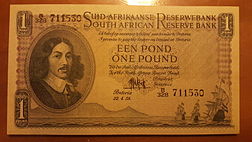South African pound
| South African pound | |
|---|---|
| Suid-Afrikaanse pond (Afrikaans) | |

1 Pound note from 1958
|
|
| Denominations | |
| Subunit | |
| 1/20 | shilling |
| 1/240 | penny |
| Plural | pond (Afrikaans only) |
| penny | pence (English only) |
| Symbol | £ |
| shilling | s |
| penny | d |
| Banknotes | 10s, £1, £5, £10, and £100 |
| Coins | |
| Freq. used | ¼d, ½d, 1d, 3d, 6d, 1s, 2s, 2½s |
| Rarely used | 5s |
| Demographics | |
| User(s) |
|
| Issuance | |
| Central bank | South African Reserve Bank |
| Website | www.reservebank.co.za |
|
This infobox shows the latest status before this currency was rendered obsolete.
|
|
The pound (symbol £) was the currency of the Union of South Africa from the creation of the country as a British Dominion in 1910. It was replaced by the rand in 1961, the same year that South Africa became a republic.
In 1825, an imperial order-in-council made sterling coinage legal tender in all the British colonies. At that time, the only British colony in Southern Africa was the Cape of Good Hope Colony. As time went on, the British pound sterling and its associated subsidiary coinage became the currency of every British territory in Southern Africa. The pound at that time was subdivided into 20 shillings, each of 12 pence.
The pound sterling became the standard currency of the Cape of Good Hope colony in 1825 following an imperial order-in-council that was issued for the purpose of introducing the sterling coinage into all the British colonies. British coins then replaced the Dutch currency. Before a unified South Africa, many authorities issued coins and banknotes in their own pound, equivalent to sterling.
The Transvaal Republic, the Boer state that in 1902 was to become Transvaal Colony, issued notes from 1867 to 1902 and coins from 1892 to 1902. The gold coins were denominated in pond rather than pounds.
In 1920, the Treasury issued gold certificate notes. The following year, the South African Reserve Bank was established as the sole note issuing authority. Coins were issued from 1923. The South African pound remained equal to the pound sterling throughout its existence, except for a short period following the abandonment of the gold standard in the United Kingdom in 1931. When the United Kingdom abandoned the gold standard in September 1931, Canada quickly followed suit because it had been under exactly the same pressure as the United Kingdom. The contraction of the money supply in the United States had been causing large amounts of gold bullion to flow west across the Atlantic Ocean, and south into the United States. The situation in South Africa was different, because gold exportation to London was a major business. According to Jan Smuts in his biography, the Nationalists specifically wanted to make a point of not automatically following suit with the United Kingdom, and they perceived that they were in a strong position to do so. For the United Kingdom and Canada, an outflow of gold was seen as a flight of gold, whereas for South Africa the same was seen as a profitable enterprise. The effect of South Africa's continuing adherence to the gold standard did not however turn out as Hertzog might have hoped. The South African pound rose dramatically in value against the pound sterling, and this virtually crippled South Africa's gold export industry overnight. By 1933, Hertzog abandoned the gold standard and the South African pound returned to parity with the pound sterling. The relief was felt almost immediately.
...
Wikipedia
